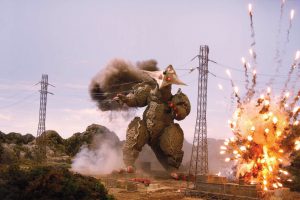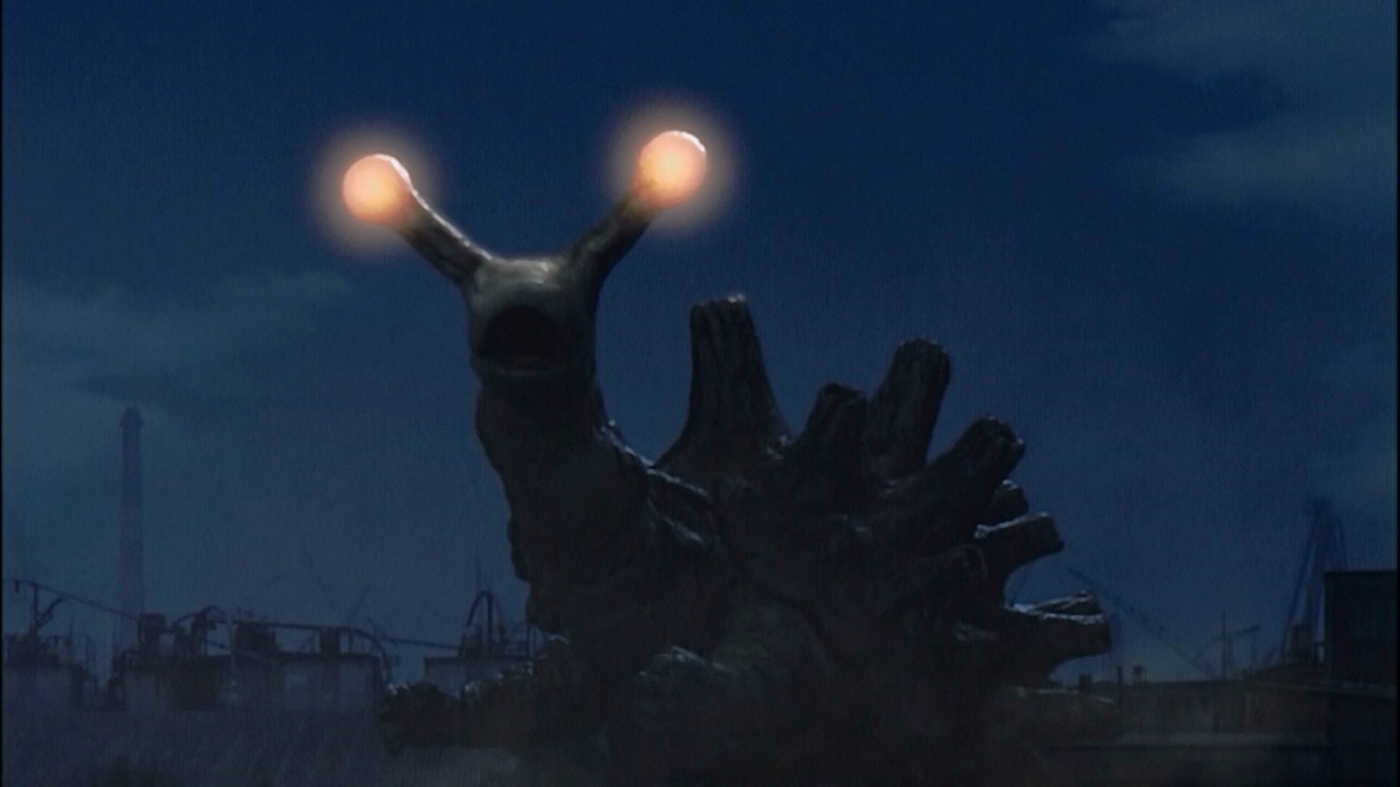Note: for the purposes of this article (and in general), the author defines a “kaiju” movie as a Japanese-produced or Japanese-inspired giant monster film.
In the kaiju circles I run in, we tend to refer to the period between (and including) 2007 and 2012 as the “wilderness years”, i.e., a time when the output of new, original kaiju media reached a significant low. That’s not to say there wasn’t anything new – independent films like Deep Sea Monster Raiga and the short Geharha, the Dark and Long-Haired Monster unobtrusively appeared in 2009, while the omnipresent Ultraman franchise quietly but steadily beat on against the popular current. A perceived lack of output is not the reason we refer to this time as a wilderness. Indeed, there was almost at least one new production for each of the aforementioned years. Rather, the wildly varying quality of this period’s output is a bigger contributor. The most defining factor, however, is the lack of a big name franchise to anchor this period, with Toho having put Godzilla on self-imposed retirement in 2004, and a new Gamera franchise failing to take off after 2006’s Gamera the Brave.
In the 1960s, the presence of rival studios Toho and Daiei’s mega-franchises allowed competing production houses to throw their hats into the kaiju ring: Nikkatsu offered up Gappa, the Triphibian Monster (1967), Toei introduced us to The Magic Serpent (1966), and crashing down to Earth came The X From Outer Space (1967), from Shochiku. With Godzilla and Gamera raking in mega-bucks at the box office, these alternative offerings were able to bask in reflected glory. However, between 2007 and 2012 no such big franchises existed, and while Ultraman persisted, his popularity and box office draw was the lowest it had been since the franchise was resurrected with Ultraman Tiga (1996). During Godzilla’s Millennium series (1999 to 2004), Japanese filmgoers became fatigued with the varying quality of each successive production, and eventually grew tired of giant monster action on the big screen. When Gamera’s attempted resurrection appeared in 2006, it never stood a chance – the cultural climate simply rendered it dead on arrival.

The wilderness years nonetheless represent something relatively unique in the history of the genre: a surprisingly high number of kaiju comedies were produced in this time. Much like the spaghetti-western in the ‘70s, kaiju filmmakers sought to keep the genre alive by introducing over-the-top comedic elements to the traditional genre structures in the search for something fresh and new. The first of the big kaiju comedies was Hitoshi Matsumoto’s Big Man Japan, released in 2007. Something of an absurdist deconstruction of the “giant hero” genre, the film features Matsumoto himself as a deadbeat loser with no friends, strained relationships with his few family members, and a lifestyle just above the poverty line – and who also possesses the hereditary ability to transform into a giant to combat kaiju attacks. In a highly surreal ending – even by this film’s standards – Big Man Japan makes a statement about Japan’s uneasy relationship with its super-powered ally, the United States, with Big Man himself rendered obsolete by the sudden appearance of a troupe of red, white, and blue Ultraman parodies. Acting as something not unlike a kaiju play on This is Spinal Tap!, Big Man Japan is arguably not the most culturally accessible kaiju comedy for Western viewers, but certainly represented something entirely new for the genre during a time when it desperately needed exactly that. Sadly, for the twisted brilliance of every Spinal Tap!, there’s sure to be an equivalent Superhero Movie, Epic Movie, or…
Minoru Kawasaki’s Monster X Strikes Back! Attack the G-8 Summit: a satirically flaccid attempt to parody the leaders of the free world, and a film that could not have come at a worse time. Resurrecting the monster Guilala from The X From Outer Space after an absence of 41 years on the screen, the film makes two tardy fundamental errors: coming along after Godzilla and Gamera were both discharged from active duty, and reviving a one-shot monster that hadn’t been seen on the big screen (in any non-stock footage cameo capacity) for four decades. Even then, Guilala’s big screen debut occurred during the complete opposite of the wilderness years: the “Kaiju Boom” of the 1960s. Further damaging was the film’s overt use of stock footage from The X From Outer Space to represent Guilala’s rampage, and the complete lack of acting ability present within any of the performers playing the G-8 leaders. Apparently in Japan in 2008, it was easier to find a Bill Clinton lookalike rather than a George W. Bush.

2008 also saw the release of Great Decisive Battle! Superior Ultraman 8 Brothers, the 20th theatrically released Ultraman movie. Featuring return appearances from characters that spanned over 40 years of the franchise, the film is a very entertaining one, but ultimately tumbles into the pitfall that so many Ultraman features do: overdependence on audience familiarity with the franchise’s rich history. This problem is especially highlighted by the fact that the film largely takes place in an alternate universe with equally alternate versions of otherwise familiar characters.
2009 was kinder to the kaiju genre, with an overall more favourable slew of features releasing. Shinpei Hayashiya, responsible for the legendary fan-film Gamera 4: Truth (2003), released the second film in his Reigo/Raiga series, Deep Sea Monster Raiga. A sequel to 2005’s Reigo: The Deep Sea Monster vs. the Battleship Yamato, the film – to put it lightly – is an uneven one, and suffers from a wildly irregular tone and some flat attempts at humour. Nonetheless, Hayashiya’s adoration of the genre shines through just enough to make the film at least an enjoyable one. An even more affectionate tribute to the genre shines through in the 20-minute short Geharha: The Dark and Long-Haired Monster. Featuring direct homages to the likes of Ishiro Honda genre favourites Invasion of the Astro-Monsters (1965) and The Mysterians (1957), Geharha benefits from a brisk running time and breakneck humour, all the while being careful not to mock the genre itself, but just affectionately have fun with it. Director Kiyotaka Taguchi would very deservedly go on to anchor the Ultra series’ return to glory, working on the television productions Ultraman Ginga (2013), Ultraman X (2015), and Ultraman Orb (2016), as well as their movie counterparts.
Sadly, the same adulation cannot be given to Tomoo Haraguchi’s Death Kappa (2010). Produced with noble intentions – to film a new, original kaiju feature created entirely through the use of traditional tokusatsu effects techniques – Death Kappa is ultimately nothing short of a train-wreck of a movie. Much of the humour is detrimentally absurd, and some jokes commit the cardinal sin of actually making fun of the genre and techniques it claims to be paying homage to. Haraguchi’s intentions were certainly commendable, but the finished product ranks among the very worst of the kaiju genre and –dishearteningly – is a film that betrays its own modus operandi. Haraguchi’s efforts (or lack thereof) are doubly disappointing considering he previously worked on the outstanding special effects of Gamera: Guardian of the Universe (1995), and Gamera 2: Advent of Legion (1996). Aside from cameos from future Shin Godzilla directors Hideaki Anno and Shinji Higuchi, Death Kappa is ultimately a film best left forgotten about, and most likely will be.
The wilderness years also saw the release of two further Ultraman films: 2009’s Mega Monster Battle: Ultra Galaxy Legends! The Movie, and its direct sequel Ultraman Zero: The Revenge of Belial in 2010. Both films are among the very best of the theatrical Ultra series, and thrust the franchise’s visuals light-years forward by liberally combining traditional tokusatsu effects with substantial helpings of green-screen and CGI. While gratuitous green-screen photography can look ugly when used in excess, the vast space opera-esque landscapes richly brought to life in these two Ultra-films are a testament to Tsuburaya Productions’ willingness to try new things to ensure their most iconic franchise remains relevant, fresh, and most importantly fun, without ever betraying or abandoning the core dynamics and conceits of the franchise.

In these uneven times, however, emerged a diamond in the rough: Kotaro Terauchi’s Demeking, the Sea Monster, a 2009 theatrical adaptation of a popular 1991 manga by Takashi Imashiro. Despite an arguably misleading title, Terauchi’s film is a quietly beautiful meditation on the importance and inevitability of accepting the responsibilities that come with growing up. The sea (in actuality, space) monster of the title only appears in a magnificently shot dream sequence – something the film has received frustratingly undeserved scorn for from the wider Western kaiju community – and this is absolutely to the film’s benefit. Demeking becomes a coming-of-age subversion of the genre itself: a kaiju movie without a kaiju, or at least the literal physical appearance of one within the film’s internal world. While certainly not for the average viewer who is simply looking to enjoy a traditional monster romp, Demeking is a woefully underrepresented and underseen movie that stands out as the crowning jewel of a difficult period in the kaiju genre’s history.
It’s worth mentioning that these wilderness years also saw Heisei Godzilla special effects director Koichi Kawakita release his short film The God of Clay, while in 2009 the independent feature Daikaiju Eiga “G” was unleashed. All was not quiet on the Western front with the highly-secretive release of Cloverfield, while on Japanese television, Tsuburaya Productions released Ultraseven X, two seasons of Ultra Galaxy: Mega Monster Battle, and the compilation clip-show Ultraman Retsuden. In 2010, Daimajin Kanon reintroduced Daiei’s stone idol in a serialised television format with mixed degrees of success. The wilderness ended in 2013, a year which saw the seeds of the current kaiju renaissance being planted. Guillermo Del Toro’s mechs-against-monsters epic Pacific Rim paved the way for Legendary’s MonsterVerse, the Ultra franchise returned to television and began its ongoing success streak with Ultraman Ginga and Neo Ultra Q, with each subsequent series proving more successful than the last. Minoru Kawasaki also released his second kaiju feature, Earth Defence Widow – but the least said about that, the better. As previously posited, these wilderness years are defined not by their lack of kaiju productions, but instead by the absence of a steady ongoing franchise to anchor the period, and the inconsistent quality of the content these years did produce. Regardless of the value of the period as a whole, this ragtag group of productions kept the flame of the kaiju genre burning long enough for it to be rekindled with the worldwide genre resurgence we enjoy today.

